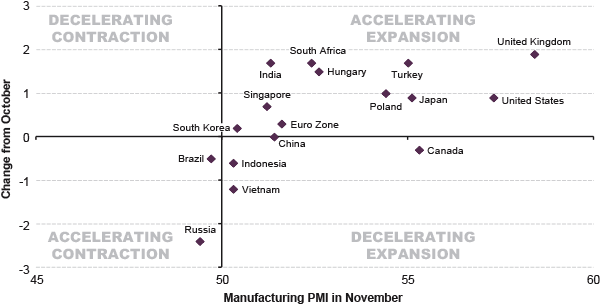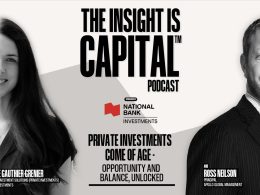December 04 2013
Major developed economies are all contributing to global economic growth, and this improving fundamental picture, coupled with ongoing monetary accommodation, bode well for risk assets.
by Scott Minerd, CIO, Guggenheim Partners LLC
The global economy is at the start of the first global synchronous expansion since 2007. In Europe, the periphery has lived through a depression, but as prices have declined, unit labor costs have fallen, spurring recovery. Overall, Europe is expanding and the outlook is further buoyed by rising expectations that the European Central Bank will likely engage in some form of quantitative easing. Chinese manufacturing data showed strength over the weekend, and while not reflecting vibrant growth, it is reasonable to say that the worst is probably behind Asia’s largest economy for the time being.
In the United States, Black Friday retail sales were somewhat disappointing at first glance. The lower level of sales were likely the result of deeper price discounts, suggesting that the U.S. economy could face deflationary pressure. That concern, coupled with stubbornly high unemployment, indicates that there is only a remote chance that the Federal Reserve will change monetary policy in December and risk upsetting the crucial holiday retail season. Interest rates, therefore, should remain range bound through the end of the year and Fed-driven liquidity will likely continue pushing U.S. stocks higher.
Any eventual change in QE will almost certainly be accompanied by incoming Fed Chairman Janet Yellen changing forward guidance, such as keeping rates at the zero bound until 2016, and possibly reducing the unemployment threshold to 6 percent from 6.5 percent. So, absent an unexpected shock that could disturb financial markets, the current environment should remain favorable for risk assets.
Historically, after a year with such strong U.S. stock returns as we have seen this year, equities have continued to climb on average another 7 percent in the first quarter of the next year. Still, long-term investors should remain wary that this rally is in a late phase, but for now, momentum and monetary accommodation should drive asset prices higher, and some of the sharpest gains often come as the market nears its peak.
Chart of the Week
Signs of Synchronized Global Expansion
The latest readings of global Purchasing Manager Indices (PMIs) reflect a convergence in manufacturing activities across different regions. Major advanced economies, including the United States, United Kingdom, Japan, and the euro zone, have seen expanding manufacturing activities for five consecutive months through November. Benefiting from the recovery in external demand from advanced economies, manufacturing activity in most emerging countries such as China, India, South Africa, and Turkey has also returned to expansion after a slump over the summer. One exception is that manufacturing activities in some commodity-driven countries continue weakening as major commodity prices remain depressed.
NOVEMBER 2013 GLOBAL MANUFACTURING PMI* OVERVIEW

Source: Markit, Haver Analytics, Guggenheim Investments. Data as of 11/30/2013. *Note: The PMI data for the U.S. is from the ISM manufacturing index, for China is from the official PMI index, and for other countries are from Markit.
Economic Data Releases
Encouraging Data from ISM, Home Sales, and Confidence
- The ISM manufacturing index rose to 57.3 in November, the highest since April 2011.
- New home sales surged in October to an annualized pace of 444,000, a 25.4% jump from September’s low.
- The November University of Michigan consumer confidence index increased for the first time since July, rising to 75.1 from 73.2.
- The leading indicator index rose more than expected in October, up 0.2%, the fourth consecutive month of growth.
- Durable goods orders fell 2.0% from a month earlier in October. Excluding transportation orders were down 0.1%. Non-defense capital goods orders, excluding aircraft, unexpectedly fell for a second month.
- Construction spending in the United States increased 0.8% in October after September’s 0.3% decline.
- The U.S. trade deficit narrowed in October to -$40.6 billion after widening for the past three months.
- The ISM non-manufacturing index was under expectations at 53.9 in November, down from 55.4.
- Initial jobless claims continued to decline for the week ended November 23rd, reaching 316,000 after the eighth straight decrease.
- Mortgage applications dropped 12.8% for the holiday shortened week ended November 29th, the worst week since September 6th.
Growth Remains Steady in the Euro Zone and China
- The euro zone manufacturing PMI for November was revised up to 51.6 in the second estimate.
- The November euro zone services PMI was revised up to 51.2 from 50.9 in the second estimate, helped by Germany’s revision from 54.5 to 55.7, the highest since January.
- Euro zone retail sales fell for a second consecutive month in October, down 0.2%. The year-over-year reading returned to negative territory after September’s positive reading.
- Euro zone economic confidence rose more than expected in November, reaching a 27-month high of 98.5.
- The euro zone unemployment rate ticked down to 12.1% in October, the first decrease since February 2011.
- The euro zone CPI increased to 0.9% year-over-year in November from 0.7% in October.
- German unemployment increased for a fourth consecutive month in November, rising by 10,000.
- German retail sales decreased for a second consecutive month, unexpectedly falling 0.8% in October.
- French consumer confidence inched down from 85 to 84 in November.
- Italy’s services PMI slipped into contractionary territory in November at 47.2 following two months in expansion.
- China’s official manufacturing PMI showed a steady pace of expansion in November, remaining at 51.1. The HSBC manufacturing PMI ticked down from 50.9 to 50.8.
- China’s non-manufacturing PMI slowed slightly in November, from 56.3 to 56.0.
- Japan’s CPI was unchanged in year-over-year terms in October, remaining at 1.1%. Excluding food and energy, the CPI rose 0.3% from a year earlier, up from 0.0% in September.
- Japanese industrial production rose a less-than-expected 0.5% in October.
Copyright © Guggenheim Partners LLC












